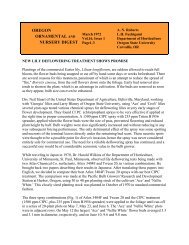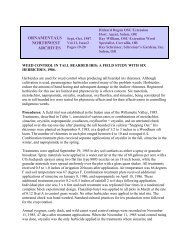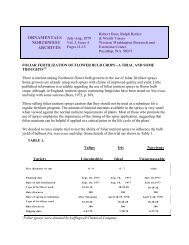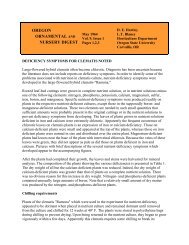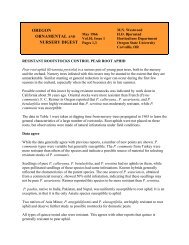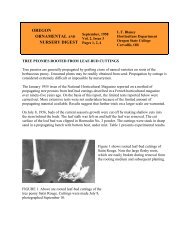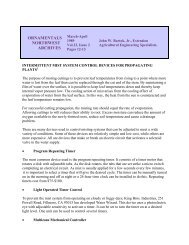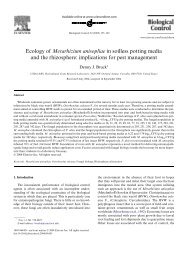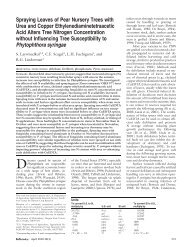Douglas-Fire Needle Midge.....Determining a Spray Schedule ...
Douglas-Fire Needle Midge.....Determining a Spray Schedule ...
Douglas-Fire Needle Midge.....Determining a Spray Schedule ...
Create successful ePaper yourself
Turn your PDF publications into a flip-book with our unique Google optimized e-Paper software.
Eggs The female flies lay eggs on the surface of new needles where they itch in a few days.<br />
Larvae: The newly emerging larvae quickly enter the needle and feed throughout the summer.<br />
Larvae of each species cause slightly different needle damage (see Figure 1). All three forms,<br />
however, mine the needle, often several larvae being present in one needle, and form gall-like<br />
structures. The needles become discolored, ranging from yellowish to purple. When mature, the<br />
larvae are about one-eighth inch long and yellowish, white or orange in color. Larvae leave the<br />
needles in the fall and over-winter in the soil.<br />
Figure 3. Feeding damage and<br />
exposed larvae in <strong>Douglas</strong>-fir<br />
needles. This stage of life cycle<br />
can be found in late summer or<br />
early fall.<br />
Larvae emerge the following spring as adults from the ground beneath the host trees about the<br />
time <strong>Douglas</strong>-fir buds are bursting.<br />
Timing for application of an insecticide, however, should be determined not by observing bud<br />
development, but by monitoring emergence. Because of the long interval of <strong>Douglas</strong>-fir bud<br />
break in Christmas tree plantations, lasting three weeks or more, needle length should not be<br />
used as a criteria.<br />
The most reliable means of determining emergence is the use of an emergence trap. The<br />
emergence period during which adults emerge from the larvae that over-wintered in the soil is of<br />
relatively short duration, approximately 10 days. Life span of the adults ranges from 1-4 days.<br />
Insecticide treatment should be timed to coincide with the period of adult female midge<br />
emergence.<br />
Construction of an Emergence Trap<br />
A trap can be constructed using any weather resistant material such as sheet metal, plywood, or<br />
heavy cardboard (wax coated shipping boxes are ideal). Construct or use a box with at least a 15<br />
inch square opening on one side. Several inches from the bottom on one side of the box, cut a<br />
circular hole slightly smaller than the lid of a wide mouth glass jar. A pint or quart size Mason<br />
jar works well. Secure the collection jar to the side of the box. When this trap is placed on the<br />
ground close to a tree, the emerging midges are attracted to the light and enter the jar.<br />
Condensation makes it necessary to place paper toweling in the jar. The trapped midges come to<br />
rest on the paper, and this facilitates counting. Set the trap on the north side of a tree in an area<br />
where damage has been observed. In large plantations where differences in elevation or sun<br />
exposure exist, additional trap locations may be indicated to monitor variations in midge<br />
emergence due to microclimate differences.





